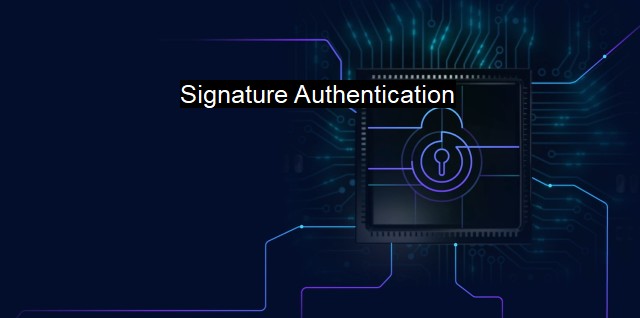What is Signature Authentication?
Securing Your Data: The Importance of Signature Authentication in Antivirus Software
Signature authentication is a significant security protocol implemented to ensure and validate a user's identity while interacting with software and hardware infrastructure. It's highly efficient, streamline, and highly credible means of verifying a person's identity, primarily via digital platforms. The authenticity assurance accorded by signature authentication teeters on the studied leverage of unique, personal attributes electronically captured, stored, and referenced when the need for identity validation arises.Signature authentication borrows the premise from the traditional handwritten signature, an identifier of a person's agreement and authenticity over centuries. it transforms it into a highly digitized format, capable of cutting through the limitations suffered by its handwritten counterpart. It performs on the features, such as speed, pressure, directional stroke, and overall writing rhythm that are exclusive to an individual.
Prout indeed, digital signature authentication goes beyond name inscriptions. Its multidimensional approach to self-identification compounds both physiological and behavioral patterns in principle operations. This modern usability practice jettisons the refinement of static biometrics, including facial recognition, finger print scans, and iris scans, bringing an extra layer to these biometric practices by introducing strokes, movements and other dynamic behavioral attributes to identification. This further minimizes chances of forgeries or false identity risks, which underscores its claim as the future go-to identity validation form, especially in cybersecurity and antivirus circles.
What qualifies signature authentication as an attractive remedy to prevalent cyber threats lies in its capability to trap advanced cyber-attacks. Without breaching established privacy protocols, the system conveniently mines and stores individual electronic identifiers. On request and during transactions, these identifiers are spontaneously compared to delivery top notch accuracy. This stringent procedure essentially makes an approved user the only entity capable of initiating seamless digital interactions.
Cybersecurity mainly revolves around acceding or denying privileges. In this context, signature authentication serves as a logical firewall, preventing illegal system infiltrations. Cyber signatures, a unique series of specific pattern-related instructions for malware detectors to detect malware activity, informs cybersecurity software to scrutinize and quarantine tainted files, based on the threat level. The antivirus then counters the actions, leaving cybercriminals desperate and unsuccessful.
Consequently, signature-based antivirus software cautions systems against possible virus threats. It operates by preemptively compiling an index of identified viruses. When a file enters the system, it systematically investigates file contents, juxtaposing them against its virus directory. Should irregularities pop up, indicative of virus characteristics, the software ideally keeps off the threat, thereby securing the system.
Though intriguingly comprehensive, signature authentication is yet to claim perfection. Despite proving crucial in emergency situations, it does not guarantee 100% security. Cybercriminals continue to showcase profound creativity in battling the rigid firewalling strategies, frequently throwing signature authentication utility into fits of frenzy. the "cat and mouse" game continues to be evident. Dynamic cybersecurity approaches demand continuous updates and evolution of defenses to ensure a robust and maintained edge against cyber threats.
Signature authentication and related signature-based antivirus software present potential growth horizons about cybersecurity. Their multifaceted character that marries physically unique aspects to behavioral attributes elucidates an ageless solution against an ever-evolving crime field. there is a need to improve particularly in marrying signature authentication procedures with machine learning and artificial intelligence. This can strengthen the response to the steadily shifting cybercriminal tactics, advancing the cause towards an impenetrable future.

Signature Authentication FAQs
What is signature authentication in the context of cybersecurity and antivirus?
Signature authentication is a process that involves comparing the digital signature of a file or software against a known, trusted signature to determine whether it is legitimate or malicious. In cybersecurity and antivirus, signature authentication is used to detect and prevent malware and other cyber threats from infecting systems.How does signature authentication work?
Signature authentication works by creating a unique digital signature for a file or software. This signature is generated using a mathematical algorithm that creates a cryptographic hash based on the contents of the file. The signature is then compared against a database of known, trusted signatures to determine if it matches any known threats. If there is a match, the file or software is flagged as dangerous and blocked or removed.What are the limitations of signature authentication?
Signature authentication has some limitations. For example, it only works for known threats, so if a new, zero-day attack is launched, signature authentication may not be effective. Additionally, attackers can create polymorphic or encrypted versions of malware that can evade signature-based detection. As a result, signature authentication is just one of the many tools used in cybersecurity and antivirus to protect systems.How can I ensure that my antivirus software is using the latest signatures?
Most antivirus software automatically updates its signature database on a regular basis to ensure that it has the latest signatures for known threats. However, it is still important to check the settings of your antivirus software to ensure that it is set to check for updates regularly. You can also manually update the signature database in some antivirus software to ensure that it is up-to-date.| | A | | | B | | | C | | | D | | | E | | | F | | | G | | | H | | | I | | | J | | | K | | | L | | | M | |
| | N | | | O | | | P | | | Q | | | R | | | S | | | T | | | U | | | V | | | W | | | X | | | Y | | | Z | |
| | 1 | | | 2 | | | 3 | | | 4 | | | 7 | | | 8 | | |||||||